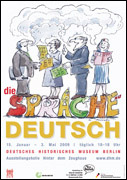


Exhibition
| Language and Language Acquisition
| History of the Language
The Art of Writing and Speaking
| Language and Technology
| The Living Language
According to linguistic studies, a new language stage, the so-called Late New High German, came about in the middle of the 20th century. Characteristic for this phenomenon is that, parallel to the standard German language practiced by various social classes and groups, there are numerous equally valid regional, functional and situational variants. There is a certain amount of interaction between the standard language and these variations, such as the change in dialects due to the influence of standard German or the effect of youth language on colloquial speech. Modification, diversity and multiplicity therefore characterize the current situation of the German language, which is constantly changing and taking in new influences. In this way it remains lively and versatile. In Europe German is spoken in the Federal Republic of Germany, Austria, Italy in parts of South Tyrol, Liechtenstein and Switzerland. In addition there are a number of linguistic enclaves worldwide where emigrants have settled.
